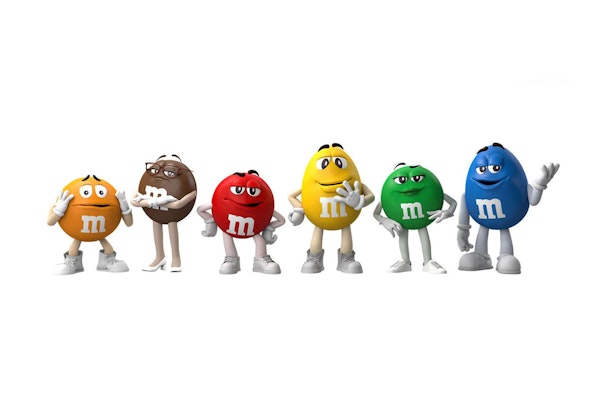Why M&M’s is being rightly rinsed for its ‘progressive’ rebrand
M&M’s has been blasted for its ’woke’ makeover of its beloved characters. Tim Jones, strategy director at Venturethree, spells out for us where it all went wrong.

M&M's received harsh feedback on its 'progressive' rebrand
Last Friday, M&M’s announced its “global commitment to creating a world where everyone feels they belong” – which was nice. I mean, it’s certainly better than “fill the world with sugar so our shareholders can profit”.
Not satisfied with a brand intent that might have felt more at home at an 80s beauty pageant, the brand’s statement goes on to promise it will “use the power of fun to include everyone” with the goal of “increasing the sense of belonging for 10 million people around the world by 2025”. If nothing else, M&M’s certainly can’t be accused of lacking ambition.
The rinsing it then received may well be attributable to its first choice of vehicle; tasked with carrying this gargantuan agenda is an executional update to the visual identity and packaging. Even if we suspend our disbelief for a moment and assume M&M’s has the right to tackle global sense of belonging, a new wardrobe is hardly the best statement of intent. Rich promise. Poor proof.
Also not helping is the articulation of the ambition itself. Carrying concepts like community, belonging, fun and inclusivity, it’s so big that it is rendered blunt. What’s the real intent here? I get (I think) the thought of a sweet, multi-colored, sharing bag wanting to celebrate individuality. Like Revels and adventure. Or Maltesers and the lighter side of life. But the other things are pushing the envelope (packaging) so far you start to lose sight of what’s in the bag. And individuality isn’t even in the verbiage!
Therein lies the second problem. In pursuit of these bigger concepts, M&M’s has undermined its true high ground. Two things I know about the brand’s professed target audience of progressive Gen Z-ers is that they are more about me than we, and authenticity conquers all. So why on sugar-covered earth have you ripped go-go boots and a sense of individuality from Green? This is more than a brand positioning semantics misstep, it’s also tantamount to “slut-shaming” (an accusation levelled by Rolling Stone, among others). So not so inclusive.
In short, the waffle at the top is causing issues in execution. Here is where I would use a brand belief to really sharpen and center the brand intent. And, for me, that is individuality. A belief that it’s more fun to just be who you want to be. Whatever your color, size, shoe preference, don’t listen to anyone. Especially not the brand and comms team at M&M’s. Above all, don’t lose perspective. Life should be fun. After all, we’re just sweets, etc.
Now, following that thought (and ignoring the fact Gen-Z have been roundly pigeon-holed by M&M’s as anxious, androgenous activists), allowing Orange to embrace his anxiety is maybe not so bad. But mental health alone is big, important stuff – enough purpose for even the bravest and biggest brands. If you want to walk this path, then you really need to be prepared to walk it…
It is action that defines character, not design updates. And with such lofty ambitions for such small little candies, it is hard to see the meaningful corporate action coming from this. M&M’s owner Mars may yet announce the overhaul of its leadership team to become more diverse or ring-fence a significant proportion of profits to improve mental health among young men. It’s this sort of behavior that might suggest it has found purpose. Shaving a few inches off the heels of a cartoon sweet? Less convincing.
The most critical failure – from a brand perspective – is that M&M’s has simply forgotten that true purpose does not need to be social. That’s why this rebrand is being roundly battered across the internet; its purported ‘purpose’ is wholly divorced from its business. Who wants to multi-colored snacks to opine on inclusivity – especially when there isn’t clear evidence on how it’ll make that ambition a reality?
Unfortunately for consumers, very few brands seem to be aware of this truism. Purpose is really the belief that drives a company forward on every level, from operations to a communications strategy, the boardroom and beyond. It’s really that simple. And it doesn’t have to be lofty either. Ryanair is a great example of a business that has embraced the simple fact – and won hordes of new Gen Z fans as a result.
Unabashed about the fact its USP is enabling people to fly cheaply, Ryanair’s TikTok account is one of the most successful corporate accounts on the app and its clarity has also freed up its social media strategist to interact authentically and fluidly with the (predominantly) Gen Z audience. This total clarity on what Ryanair’s purpose is means that, whatever happens on a comms level, it will always be aligned with who Ryanair is and what it does. This in sharp contrast to M&M’s rebrand, which feels both uncomfortably considered and at odds with the core business proposition.
Rising above the cringe, I sincerely hope that M&M’s has more meaningful action up its sleeves that it has yet to announce. In the meantime, its leaders are sure to have learned the lesson that purpose must run far deeper than shoe choices.
Tim Jones is strategy director at Venturethree.
